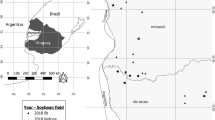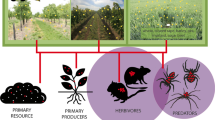Abstract
Insecticide use remains both ubiquitous and controversial around the world, due to its importance despite acknowledged inherent environmental risk. Neonicotinoid insecticides have been targeted as potential culprits of reported pollinator declines and decreases in insect abundance and diversity. Having systemic activity in plants, neonicotinoids can be used as seed treatments. Such use, associated with a relatively higher water solubility and soil persistence, may enhance the potential of these compounds to change the structure and function of food webs associated with crop plants. We therefore conducted a food web analysis to assess the short-term impact of seed treatments with the neonicotinoid imidacloprid on the arthropod community associated with Neotropical soybean fields. Imidacloprid-treated and untreated soybeans were cultivated for two seasons, and associated arthropods were sampled throughout the plant phenological cycle. The data collected were used to build plant–consumer–predator networks using food web analysis. We found that imidacloprid seed treatments significantly affected arthropod species richness and abundance in a preliminary analysis, thus affecting soybean-associated arthropod assemblage. However, this effect was secondary to cultivation season, unlike the findings from food web analysis where the effect of imidacloprid seed treatment prevailed. The effect of imidacloprid was significant especially on prey–predator asymmetries and proportion of taxa at higher trophic levels. Higher food web complexity was associated with imidacloprid-treated fields particularly during the 2nd cultivation season, but without impacting soybean yield. Our results suggest that imidacloprid soybean seed treatments impact the arthropod community within the crop, but do not necessarily reduce community complexity and have no noticeable effect on pest species and crop yield.




Similar content being viewed by others
Data availability
The datasets generated during and/or analyzed during the current study are available on reasonable request.
References
Badji CA, Guedes RNC, Silva AA, Araújo RA (2004) Impact of deltamethrin on arthropods in maize under conventional and no-tillage cultivation. Crop Prot 23(11):1031–1039. https://doi.org/10.1016/j.cropro.2004.03.003
Bakker L, van der Werf W, Tittonell P et al (2020) Neonicotinoids in global agriculture: Evidence for a new pesticide treadmill? Ecol Soc 25:26. https://doi.org/10.5751/es-11814-250326
Belzunces LP, Bonmatin JM, Chagnon M, Downs C (2015) Systemic insecticides (neonicotinoids and fipronil ): trends, uses, mode of action and metabolites. Environ Sci Pollut Res 22:5–34. https://doi.org/10.1007/s11356-014-3470-y
Bonmatin JM, Giorio C, Sánchez-Bayo F, Bijleveld van Lexmond M (2021) An update of the Worldwide Integrated Assessment (WIA) on systemic insecticides. Environ Sci Pollut Res 28:11709–11715. https://doi.org/10.1007/s11356-021-12853-6
Budge GE, Garthwaite D, Crowe A et al (2015) Evidence for pollinator cost and farming benefits of neonicotinoid seed coatings on oilseed rape. Sci Rep 5:1–12. https://doi.org/10.1038/srep12574
Casida JE, Durkin KA (2013) Neuroactive insecticides: targets, selectivity, resistance, and secondary effects. Annu Rev Entomol 58:99–117. https://doi.org/10.1146/annurev-ento-120811-153645
Centner TJ (2021) Pesticide usage is compromising people’s health in the united states: ideas for reducing damages. Agric. https://doi.org/10.3390/agriculture11060486
Cohen JE, Jonsson T, Carpenter SR (2003) Ecological community description using the food web, species abundance, and body size. Proc Natl Acad Sci U S A 100:1781–1786
Cordeiro EMG, Corrêa AS, Guedes RNC (2014) Insecticide-mediated shift in ecological dominance between two competing species of grain beetles. PLoS ONE 9:1–9. https://doi.org/10.1371/journal.pone.0100990
Cox WJ, Cherney JH, Shields E (2007) Clothianidin seed treatments inconsistently affect corn forage yield when following soybean. Agron J 99:543–548. https://doi.org/10.2134/agronj2006.0170
Douglas MR, Rohr JR, Tooker JF (2015) Neonicotinoid insecticide travels through a soil food chain, disrupting biological control of non-target pests and decreasing soya bean yield. J Appl Ecol 52:250–260. https://doi.org/10.1111/1365-2664.12372
Dubey A, Lewis MT, Dively GP, Hamby KA (2020) Ecological impacts of pesticide seed treatments on arthropod communities in a grain crop rotation. J Appl Ecol 57:936–951. https://doi.org/10.1111/1365-2664.13595
Frank SD, Tooker JF (2020) Neonicotinoids pose undocumented threats to food webs. Proc Natl Acad Sci USA 117:22609–22613. https://doi.org/10.1073/pnas.2017221117
Ghimire N, Woodward RT (2013) Under- and over-use of pesticides: an international analysis. Ecol Econ 89:73–81. https://doi.org/10.1016/j.ecolecon.2013.02.003
Gontijo PC, Abbade Neto DO, Oliveira RL et al (2018) Non-target impacts of soybean insecticidal seed treatments on the life history and behavior of Podisus nigrispinus, a predator of fall armyworm. Chemosphere 191:342–349. https://doi.org/10.1016/j.chemosphere.2017.10.062
Guedes RNC, Smagghe G, Stark JD, Desneux N (2016) Pesticide-induced stress in arthropod pests for optimized integrated pest management programs. Annu Rev Entomol 61:43–62. https://doi.org/10.1146/annurev-ento-010715-023646
Guedes RNC, Walse SS, Throne JE (2017) Sublethal exposure, insecticide resistance, and community stress. Curr Opin Insect Sci. https://doi.org/10.1016/j.cois.2017.04.010
Guedes RNC, Rix RR, Cutler GC (2022) Pesticide-induced hormesis in arthropods: towards biological systems. Cur Op Toxicol 29:43–59. https://doi.org/10.1016/j.cotox.2022.02.001
Gunstone T, Cornelisse T, Klein K et al (2021) Pesticides and Soil Invertebrates: a Hazard Assessment. Front Environ Sci 9:643847. https://doi.org/10.3389/fenvs.2021.643847
Haro MM, Silveira LCP, Wilby A (2018) Stability lies in flowers : plant diversification mediating shifts in arthropod food webs. PLoS One 13:e0193045
Hitaj C, Smith DJ, Code A et al (2020) Sowing uncertainty: what we do and don’t know about the planting of pesticide-treated seed. Bioscience 70:390–403. https://doi.org/10.1093/BIOSCI/BIAA019
Hudson LN, Emerson R, Jenkins GB et al (2013) Cheddar : analysis and visualisation of ecological communities in R. Methods Ecol Evol 4:99–104. https://doi.org/10.1111/2041-210X.12005
Jarecki W, Wietecha J (2021) Effect of seed coating on the yield of soybean glycine max (L.) merr. Plant, Soil Environ 67:468–473. https://doi.org/10.17221/246/2021-PSE
Jeschke P, Nauen R, Schindler M, Elbert A (2011) Overview of the status and global strategy for neonicotinoids. J Agric Food Chem 59:2897–2908. https://doi.org/10.1021/jf101303g
Krupke CH, Tooker JF (2020) Beyond the headlines: the influence of insurance pest management on an unseen, silent entomological majority. Front Sustain Food Syst 4:595855. https://doi.org/10.3389/fsufs.2020.595855
Labrie G, Gagnon AÈ, Vanasse A et al (2020) Impacts of neonicotinoid seed treatments on soil-dwelling pest populations and agronomic parameters in corn and soybean in Quebec (Canada). PLoS ONE 15:e0229136. https://doi.org/10.1371/journal.pone.0229136
Lamichhane JR (2020) Parsimonious use of pesticide-treated seeds: an integrated pest management framework. Trends Plant Sci 25:1070–1073. https://doi.org/10.1016/j.tplants.2020.08.002
Lebelo K, Malebo N, Mochane MJ, Masinde M (2021) Chemical contamination pathways and the food safety implications along the various stages of food production: a review. Int J Environ Res Public Health 18:5795. https://doi.org/10.3390/ijerph18115795
Luz CEA, Zuim V, Oliveira AAS et al (2021) Arthropod food webs associated with cotton: Does Bt cotton mediates community stress? J Appl Entomol. https://doi.org/10.1111/jen.12928
Malhotra N, Chen KH, Huang J et al (2021) Physiological effects of neonicotinoid insecticides on non-target aquatic animals — An updated review. Int J Mol Sci 22:9591
Mohammed AAAH, Desneux N, Monticelli LS et al (2019) Potential for insecticide-mediated shift in ecological dominance between two competing aphid species. Chemosphere. https://doi.org/10.1016/j.chemosphere.2019.03.114
Moscardini VF, Gontijo PDC, Carvalho GA et al (2013) Toxicity and sublethal effects of seven insecticides to eggs of the flower bug Orius insidiosus (Say) (Hemiptera: Anthocoridae). Chemosphere 92:490–496. https://doi.org/10.1016/j.chemosphere.2013.01.111
Pedrini S, Merritt DJ, Stevens J, Dixon K (2017) Seed coating: Science or marketing spin? Trends Plant Sci 22:106–116. https://doi.org/10.1016/j.tplants.2016.11.002
R Development Core Team (2020) R Development Core Team, R: a language and environment for statistical computing, ver. 3.5.1. R Foundation for Statistical Computing
Reisig DD, Herbert DA, Malone S (2012) Impact of neonicotinoid seed treatments on thrips (Thysanoptera: Thripidae) and soybean yield in Virginia and North Carolina. J Econ Entomol 105:884–889. https://doi.org/10.1603/EC11429
Resende-Silva GA, Joseph DA, Guedes RNC, Cutler GC (2020) Impact of imidacloprid soil drenching on survival, longevity, and reproduction of the zoophytophagous predator podisus maculiventris (Hemiptera: Pentatomidae: Asopinae). J Econ Entomol 113:108–114. https://doi.org/10.1093/jee/toz283
Resende-Silva GA, Turchen LM, Guedes RNC, Cutler GC (2019) Imidacloprid soil drenches affect weight and functional response of spined soldier bug (Hemiptera: Pentatomidae). J Econ Entomol 112:558–564. https://doi.org/10.1093/jee/toy401
Rosenheim JA, Cass BN, Kahl H, Steinmann KP (2020) Variation in pesticide use across crops in California agriculture: economic and ecological drivers. Sci Total Environ 733:138683. https://doi.org/10.1016/j.scitotenv.2020.138683
Sánchez-bayo F, Tennekes HA (2020) Time-cumulative toxicity of neonicotinoids: Experimental evidence and implications for environmental risk assessments. Int J Environ Res Public Health. https://doi.org/10.3390/ijerph17051629
Schreinemachers P, Tipraqsa P (2012) Agricultural pesticides and land use intensification in high, middle and low income countries. Food Policy 37:616–626. https://doi.org/10.1016/j.foodpol.2012.06.003
Seagraves MP, Lundgren JG (2012) Effects of neonicitinoid seed treatments on soybean aphid and its natural enemies. J Pest Sci 85:125–132. https://doi.org/10.1007/s10340-011-0374-1
Shea K, Roxburgh SH, Raushert ESJ (2004) Moving from pattern to process : coexistence mechanisms under intermediate disturbance regimes. Ecol Lett 7:491–508. https://doi.org/10.1111/j.1461-0248.2004.00600.x
Smith JL, Baute TS, Schaafsma AW (2020) Quantifying early-season pest injury and yield protection of insecticide seed treatments in corn and soybean production in Ontario, Canada. J Econ Entomol 113:2197–2212. https://doi.org/10.1093/jee/toaa132
Sparks TC, Crossthwaite AJ, Nauen R et al (2020) Insecticides, biologics and nematicides: updates to IRAC’s mode of action classification - a tool for resistance managementf. Pestic Biochem Physiol 167:104587
Sparks TC, Nauen R (2015) IRAC : mode of action classification and insecticide resistance management. Pestic Biochem Physiol 121:122–128. https://doi.org/10.1016/j.pestbp.2014.11.014
Szénási A, Pálinkás Z, Zalai M (2014) Short-term effects of different genetically modified maize varieties on arthropod food web properties: an experimental field assessment. Sci Rep 4(1):1–7. https://doi.org/10.1038/srep05315
Thompson DA, Lehmler HJ, Kolpin DW et al (2020) A critical review on the potential impacts of neonicotinoid insecticide use: current knowledge of environmental fate, toxicity, and implications for human health. Environ Sci Process Impacts 22:1315–1346. https://doi.org/10.1039/c9em00586b
Tomizawa M, Casida JE (2005) Neonicotinoid insecticide toxicology: mechanisms of selective action. Annu Rev Pharmacol Toxicol 45:247–268. https://doi.org/10.1146/annurev.pharmtox.45.120403.095930
Tooker JF, Pearsons KA (2021) Newer characters, same story: neonicotinoid insecticides disrupt food webs through direct and indirect effects. Curr Opin Insect Sci 46:50–56. https://doi.org/10.1016/j.cois.2021.02.013
Tudi M, Ruan HD, Wang L et al (2021) Agriculture development, pesticide application and its impact on the environment. Int J Environ Res Public Health 18:1112. https://doi.org/10.3390/ijerph18031112
Vojvodić M, Bažok R (2021) Future of insecticide seed treatment. Sustain 13:8792. https://doi.org/10.3390/su13168792
Zhang L, Greenberg SM, Zhang Y, Liu TX (2011) Effectiveness of thiamethoxam and imidacloprid seed treatments against Bemisia tabaci (Hemiptera: Aleyrodidae) on cotton. Pest Manag Sci 67:226–232. https://doi.org/10.1002/ps.2056
Żmudzki S, Laskowski R (2012) Biodiversity and structure of spider communities along a metal pollution gradient. Ecotoxicology 21:1523–1532. https://doi.org/10.1007/s10646-012-0906-3
Zuim V, Marques VM, Godoi CTD et al (2021) Does refuge spillover affect arthropod food webs associated with Bt maize? Pest Manag Sci. https://doi.org/10.1002/ps.6388
Acknowledgements
The provision of the experimental areas and field technical support by the Department of Agriculture of the Federal University of Viçosa was greatly appreciated, as were the financial support provided for the study.
Funding
The financial support provided by the Minas Gerais State Foundation for Research Aid (FAPEMIG BDS-00488–16), National Council of Scientific and Technological Development (CNPq), CAPES Foundation (Brazilian Ministry of Education; Finance Code 001), and a Discovery Grant from the Natural Sciences and Engineering Research Council (NSERC) of Canada (RGPIN-2015–04639).
Author information
Authors and Affiliations
Corresponding author
Ethics declarations
Conflict of interest
The authors declare that they have no known conflict of interest.
Ethical approval
This article does not contain any studies with human participants or animals unduly performed by the authors.
Consent to participate
Not applicable.
Consent for publication
All authors are in accord with the submission.
Additional information
Communicated by Antonio Biondi .
Publisher's Note
Springer Nature remains neutral with regard to jurisdictional claims in published maps and institutional affiliations.
Supplementary Information
Below is the link to the electronic supplementary material.
Rights and permissions
About this article
Cite this article
Resende-Silva, G.A., Bravim, J.N., Haro, M.M. et al. Imidacloprid seed treatment in soybean-associated arthropod food webs: Reason for concern, or justifiable neglect?. J Pest Sci 96, 129–139 (2023). https://doi.org/10.1007/s10340-022-01503-6
Received:
Revised:
Accepted:
Published:
Issue Date:
DOI: https://doi.org/10.1007/s10340-022-01503-6




